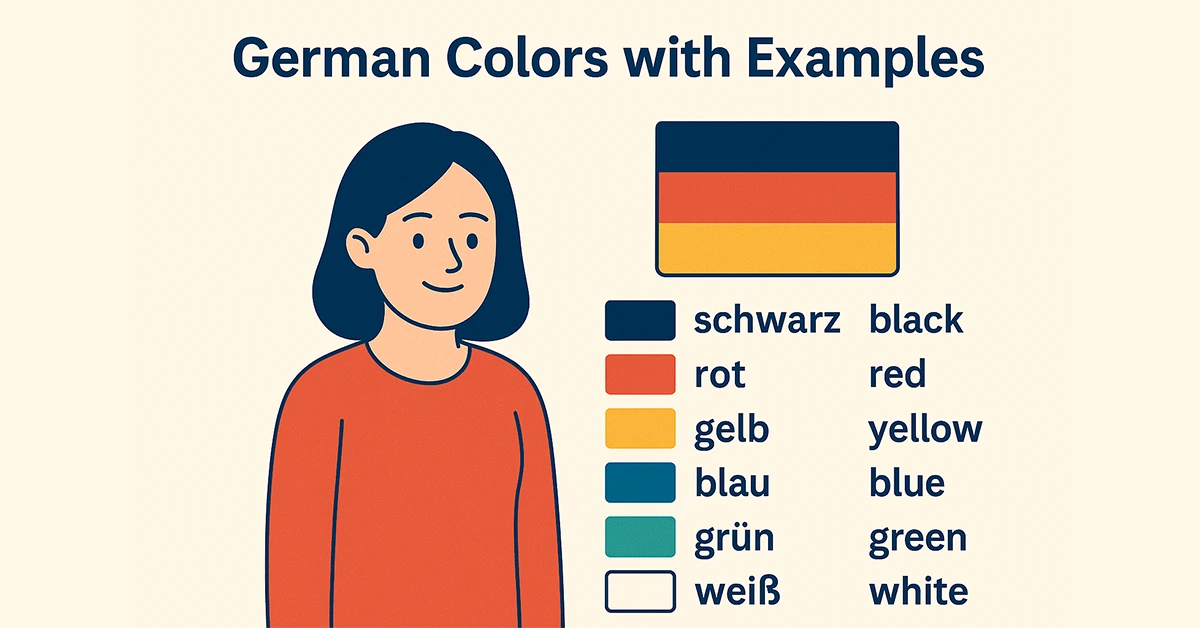German Colors with Examples – Learn die Farben in German

Master German color vocabulary with practical examples and tips. Learn how to use colors in German in real sentences, what gender they have, and how to describe things naturally.
Why Learn Colors in German?
Knowing color words helps you describe objects, people, clothing, and nature. It’s one of the most useful vocab groups for A1 learners and used in daily life conversations.
What Is “Color” in German? – die Farbe
The word for “color” in German is die Farbe (plural: die Farben). Example: Meine Lieblingsfarbe ist blau. (My favorite color is blue.)
Basic Colors in German: A Quick List
| German | English |
|---|---|
| rot | red |
| blau | blue |
| grün | green |
| gelb | yellow |
| orange | orange |
| lila | purple |
| schwarz | black |
| weiß | white |
| grau | gray |
| braun | brown |
Red, Blue, Green – Primary Colors in German
- rot – red
- blau – blue
- gelb – yellow
These are the basis for many compound color terms.
Secondary Colors and Their German Names
- grün – green (blue + yellow)
- orange – orange (red + yellow)
- lila – purple (red + blue)
Common Color Adjectives with Examples
- Der Apfel ist rot. – The apple is red.
- Das Auto ist schwarz. – The car is black.
- Meine Jacke ist grün. – My jacket is green.
How to Use Colors in German Sentences
Colors are used as adjectives and usually come after the verb sein (to be):
Die Blume ist gelb. – The flower is yellow.
Color Agreement with Nouns: Do Colors Decline?
Colors do not change for gender or case when used predicatively (with sein), but they do decline when used attributively (before a noun):
Ein grünes Hemd – A green shirt
Capitalization Rules for Colors in German
Color words are usually lowercase unless used as nouns. Example:
- blau (adjective)
- das Blau (noun: the color blue)
How to Say “Light Blue,” “Dark Green,” etc. in German
- hellblau – light blue
- dunkelgrün – dark green
- hellrot – light red
- dunkelbraun – dark brown
Fun Color Expressions in German (Redewendungen)
- grün hinter den Ohren sein – to be inexperienced
- blau machen – to skip work/school
- das schwarze Schaf – the black sheep
Colors in Clothing Vocabulary
- Ich trage ein weißes Hemd. – I’m wearing a white shirt.
- Sie kauft eine rote Jacke. – She’s buying a red jacket.
Describing Nature and Weather with Colors
Der Himmel ist blau. – The sky is blue.
Die Bäume sind grün. – The trees are green.
German Idioms Using Colors
- alles durch die rosa Brille sehen – to see everything in a positive light
- rot sehen – to become angry
Practice: Match the Color to the Object
- die Sonne – gelb
- der Apfel – rot
- der Himmel – blau
Quiz Yourself: Translate Colors from English to German
- Green = grün
- Black = schwarz
- Purple = lila
Tips to Memorize German Colors Faster
- Use flashcards with color blocks
- Label objects at home in German
- Practice with clothing and nature vocabulary
Printable Color Chart in German (PDF)
Download our printable A4 chart with 12 main German colors and example sentences for each. Perfect for visual learners!
Download: Flashcards for German Colors
Grab our free PDF flashcards for all A1 color words, designed for printing or mobile use.
Conclusion: Talk About Colors Like a Native Speaker
Once you master German color vocabulary, you’ll describe your world more confidently. Practice daily and start seeing “die Farben” everywhere you go!
Frequently Asked Questions About German Colors
What is the German word for “color”?
The word is die Farbe (plural: die Farben). Example: Meine Lieblingsfarbe ist blau.
Do German color words change with gender or case?
When used predicatively (e.g., Das Auto ist rot), color adjectives do not change. But when used before nouns, they follow adjective endings (e.g., ein rotes Auto).
How do I say “light blue” and “dark green” in German?
Add hell- for light and dunkel- for dark: hellblau (light blue), dunkelgrün (dark green).
Are German color words nouns or adjectives?
They are usually adjectives, but can become nouns when capitalized: Das Blau des Himmels – The blue of the sky.
What are some fun German idioms with colors?
Examples: blau machen (skip work), grün hinter den Ohren (naive), das schwarze Schaf (black sheep).